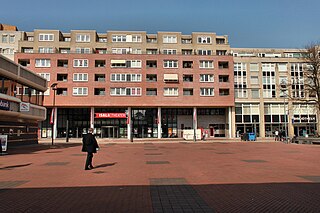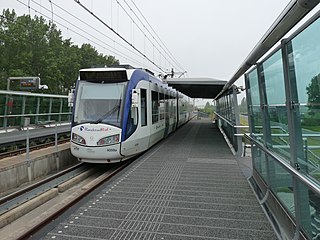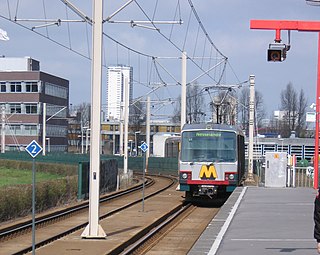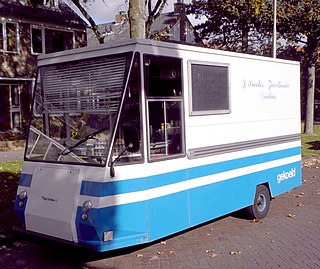
Rotterdam is the second-largest city in the Netherlands after the national capital of Amsterdam. It is in the province of South Holland, part of the North Sea mouth of the Rhine–Meuse–Scheldt delta, via the "New Meuse" inland shipping channel, dug to connect to the Meuse at first and now to the Rhine.

Capelle aan den IJssel is a large town and municipality in the western Netherlands, in the province of South Holland. The municipality had a population of 67,319 in 2021, and covers an area of 15.40 km2 (5.95 sq mi), of which 1.26 km2 (0.49 sq mi) is water. It is situated on the eastern edge of Rotterdam, on the Hollandse IJssel river.

Krimpen aan den IJssel is a town and municipality in the western Netherlands, in the province of South Holland. The municipality had a population of 29,410 in 2021, and covers an area of 8.95 km2 (3.46 sq mi) of which 1.26 km2 (0.49 sq mi) is water.

Nederlandse Spoorwegen is the principal passenger railway operator in the Netherlands. It is a Dutch state-owned company founded in 1938. The Dutch rail network is the busiest in the European Union, and the third busiest in the world after Switzerland and Japan.

HTM Personenvervoer NV is a public transport company in the Netherlands operating trams, lightrail and buses in The Hague, Rijswijk, Leidschendam, Voorburg, Delft, Zoetermeer, Wateringen, Pijnacker and Nootdorp, the so-called Conurbation Haaglanden. The lightrail connection to Zoetermeer is operated in cooperation with RET, the Rotterdam-public transport company, which operates the connection between The Hague Central Station and Slinge in the south of Rotterdam, thus giving a fast and easy connection between the two city-centres. Regional transports are serviced by Connexxion, Arriva and RET.

RandstadRail is a tram-train network in the Rotterdam–The Hague metropolitan area in the west of the Netherlands that is jointly operated by HTM Personenvervoer (HTM) and Rotterdamse Elektrische Tram (RET). It connects the cities of Rotterdam, The Hague and Zoetermeer, primarily using former train and existing tram tracks.

The Rotterdam Metro is a rapid transit system operated in Rotterdam, Netherlands and surrounding municipalities by RET. The first line, called Noord – Zuidlijn opened in 1968 and ran from Centraal Station to Zuidplein, crossing the river Nieuwe Maas in a tunnel. It was the first metro system to open in the Netherlands. At the time it was also one of the shortest metro lines in the world with a length of only 5.9 km (3.7 mi).

Vehicular automation is the use of technology to assist or replace the operator of a vehicle such as a car, truck, aircraft, rocket, military vehicle, or boat. Assisted vehicles are semi-autonomous, whereas vehicles that can travel without a human operator are autonomous. The degree of autonomy may be subject to various constraints such as conditions. Autonomy is enabled by advanced driver-assistance systems (ADAS) of varying capacity.

The national tariff system is a ticketing and zoning scheme for local public transport in the Netherlands. It was designed as a nationwide scheme but is being phased out and replaced by the OV-chipkaart. With the abolition of the strippenkaart on 3 November 2011, only the sterabonnement remains organized under the national tariff system. The system does not apply to Dutch Railways (NS), which have their own pricing regime; however, there are limited sections of railway on which the system is valid.

The OV-chipkaart is a contactless smart card and integrated ticketing system used for all public transport in the Netherlands. First introduced in the Rotterdam Metro in April 2005, it has subsequently been rolled out to other areas and travel modes. It fully replaced the national strippenkaart system for buses, trams, and metro trains in 2011, and the paper ticket system for rail travel in July 2014.

Capelsebrug is a station on lines A, B, and C of the Rotterdam Metro. The station is situated in the eastern part of Rotterdam in the Netherlands, at the boundary with Capelle aan den IJssel municipality. At Capelsebrug station, lines A and B turn north towards Schenkel station, while line C continues east towards Slotlaan station..

Kralingse Zoom is a subway station on lines A, B, and C of the Rotterdam Metro, in the Kralingen neighbourhood of eastern Rotterdam. The station is located just west of the A16 motorway on the east side of Kralingse Zoom, the road it is named after. At Kralingse Zoom station, transfer is available to several bus lines, as well as to the ParkShuttle, a people mover to a nearby business district.

Capelle Centrum is a subway station on Line C of the Rotterdam Metro and is situated in the town of Capelle aan den IJssel, just east of Rotterdam.

Schenkel is a subway station on Rotterdam Metro lines A and B, and is situated in the northeastern part of Rotterdam, in the borough Prins Alexander. The station is named after a neighbourhood in nearby Capelle aan den IJssel, situated to the southeast of the subway station.

The Government of Rotterdam is the government of the municipality and city of Rotterdam in the Netherlands. Most of the inhabitants live in the city of Rotterdam, but the municipality also covers a number of small villages, and other parts of the local government, such as Rozenburg, cover an even larger area.
The main public transport in the Netherlands for longer distances is by train. Long-distance buses are limited to a few missing railway connections. Regional and local public transport is by bus and in some cities by metro and tram. There are also ferries.

The Utrechtse sneltram, operating under the brand name U-OV, is a light rail system in the Dutch city of Utrecht. The system consists of three tram routes connecting Utrecht Centraal railway station with the residential areas of Lombok and Kanaleneiland and the suburbs Nieuwegein and IJsselstein to the southwest of the station, and with the Uithof district and Utrecht University to the southeast.

Spijkstaal is a Dutch car company from Spijkenisse, Netherlands. It specializes in electric cars, especially trucks for industrial usage. Its electric carts operate in Amsterdam Airport Schiphol, flower auctions including the Royal FloraHolland, and military airfields. Among the general public, Spijkstaal is mostly known for being the manufacturer of mobile grocery stores.

Schiphol Busnet is the name used by Connexxion to operate the public transport by bus at Schiphol Airport and the town of Schiphol, and the surrounding towns of Aalsmeer, Amstelveen, Amsterdam and Badhoevedorp. Prior to December 2017, the network was operated using the brand name Schiphol Sternet.

The Capelle train accident took place on 15 November 1899 in Capelle aan den IJssel, Netherlands, when a mail train collided with a passenger train in a heavy fog, resulting in the deaths of 8 people with a further 12 injured. It is the deadliest train accident in the Netherlands in the 19th century.




















